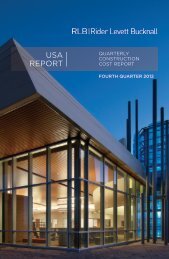International Construction Cost Commentary - Rider Levett Bucknall
International Construction Cost Commentary - Rider Levett Bucknall
International Construction Cost Commentary - Rider Levett Bucknall
You also want an ePaper? Increase the reach of your titles
YUMPU automatically turns print PDFs into web optimized ePapers that Google loves.
on the future of all SPEED related projects<br />
which, if implemented in their entirety,<br />
could potentially significantly help Arizona’s<br />
economy, which relies heavily on the<br />
construction industry.<br />
Despite the stagnant housing sector it is<br />
widely anticipated that, with The State<br />
of Arizona continuing to experience<br />
population growth, this current trend will<br />
show signs of a slow recovery in early<br />
2010. It is further anticipated that a slow<br />
recovery within commercial construction<br />
related works may follow behind the<br />
housing sector.<br />
Boston<br />
The Boston market continues its<br />
downward spiral.<br />
The residential construction market<br />
continues to struggle, with no new large<br />
scale condominium projects planned in the<br />
city and single family home construction<br />
effectively stalled. Condominium sales<br />
remain significantly below last year’s<br />
numbers and the median price of a single<br />
family home has now dropped by 14% over<br />
the last 12 months.<br />
The commercial market has suffered<br />
considerably during the credit crisis in the<br />
last 6 months, with all but a handful of the<br />
ongoing city centre developments grinding<br />
to a halt over issues with financing. Lenders<br />
have been reviewing and withdrawing<br />
financing on projects, while developers are<br />
seeking to fill their yet-to-be built office<br />
building before committing to construction.<br />
Office rents remain inflated, but with<br />
vacancy rates rising steadily as businesses<br />
downsize, this should correct over the upcoming<br />
months.<br />
Hospitals and Universities, long considered<br />
the “safe” option in Boston, have also<br />
signalled a cautious approach for the<br />
upcoming year. With issues over bond<br />
financing and reduction in endowments,<br />
the city’s major health and educational<br />
institutions have placed major capital<br />
projects under review and halted a number<br />
of high profile developments.<br />
Contractors are becoming more aggressive,<br />
and the only silver lining currently out<br />
there is that the next 12 months will be a<br />
great time to build - if finance is available.<br />
Los Angeles<br />
Los Angeles experienced significant declines<br />
in construction activity across many sectors<br />
in 2008 with residential permits down<br />
41.7% and non-residential permits down<br />
16.6%.<br />
The devastated national credit market is<br />
reflected in Los Angeles with construction<br />
lending down 52.5% and many projects<br />
struggling to break ground. Most notably,<br />
Los Angeles’ marquee project, the $2.7<br />
billion mixed-use development of Grand<br />
Avenue faces continued delays due to<br />
major financing issues.<br />
The residential market has been significantly<br />
impacted by the credit freeze. Park Fifth, a<br />
$1.3 billion 76-story development; Suncal<br />
Condo Tower, a $400 million dollar<br />
development and 9900 Wilshire Blvd., a<br />
$366 million dollar development have all<br />
been placed on hold. This trend is mirrored<br />
throughout the private sector in Los<br />
Angeles with construction loans becoming<br />
increasingly tougher to obtain.<br />
The one bright light for construction in<br />
Los Angeles is public projects. With funds<br />
already in place, these projects are avoiding<br />
the credit issues plaguing the private sector.<br />
Three major new infrastructure projects<br />
broke ground in 2008 totalling $470 million.<br />
The ongoing $869 million Metro Gold Line<br />
expansion and $504 million Tom Bradley<br />
<strong>International</strong> Terminal are both under<br />
construction until 2010. Public school<br />
construction is pushing forward with the<br />
$391 million Central Los Angeles Learning<br />
Center and two new LAUSD campuses<br />
totalling $218 million.<br />
In 2009 it is anticipated that there will be<br />
a continued reliance on the public sector<br />
to stimulate the Los Angeles construction<br />
economy, with no sign of improvement in<br />
any private sectors expected until 2010.<br />
New York<br />
The New York City area, like most<br />
major urban centres in the United States,<br />
has begun to experience a downturn in<br />
construction activity across all sectors.<br />
While construction continues on priorfunded<br />
privately financed projects, it is<br />
apparent that the area is bracing for a<br />
protracted and severe economic slowdown.<br />
The market for office space as well as<br />
luxury high-rise residences has dropped off.<br />
This, coupled with the dearth of private<br />
financing, has resulted in significant layoffs<br />
among the city’s largest developers.<br />
The hotel and hospitality sector has been<br />
particularly hard hit, experiencing declining<br />
occupancy rates in the 4th quarter of 2008<br />
(traditionally a busy season) for the first<br />
time in recent memory. It is expected that<br />
some 9,000 new rooms will come on line<br />
in 2009, mostly in the three-star and below<br />
category. No new five-star development is<br />
planned and the last of the major five star<br />
renovations is underway.<br />
The State is in the midst of a multi-billion<br />
dollar budget gap and the public sector<br />
will feel the pinch in coming months as<br />
government and agency projects are<br />
shelved. Quasi-public entities such as<br />
colleges and universities, especially privately<br />
endowed institutions, continue to develop<br />
capital projects as well as upgrades,<br />
maintenance, and even investment.<br />
Prices for major durable commodities have<br />
levelled or started to decline, especially<br />
those which are energy sensitive, in the<br />
wake of severely declining crude oil prices.<br />
Gasoline surcharges, in place for most of<br />
2008, are being rescinded.<br />
11<br />
INTERNATIONAL CONSTRUCTION COST COMMENTARY: January 2009

















